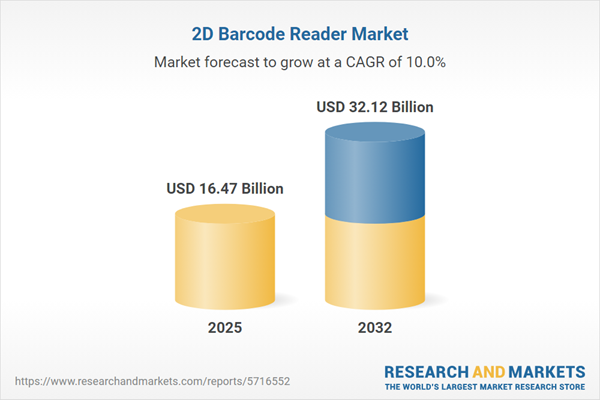Speak directly to the analyst to clarify any post sales queries you may have.
The 2D Barcode Reader Market is evolving rapidly, reshaping data capture and automation across supply chains, healthcare, and retail sectors. Senior decision-makers face new opportunities and challenges as advanced reader technologies drive digital transformation and support critical operational demands.
Market Snapshot: 2D Barcode Reader Market Growth and Trends
The 2D Barcode Reader Market grew from USD 14.94 billion in 2024 to USD 16.47 billion in 2025. It is expected to continue growing at a CAGR of 10.03%, reaching USD 32.12 billion by 2032.
This expansion reflects the strategic importance of 2D barcode readers in enabling efficiency, data accuracy, and integration within increasingly complex global operations. The rising demand for seamless digital processes in areas such as logistics, healthcare, manufacturing, and retail supports robust adoption rates and product innovations.
Scope & Segmentation: Comprehensive Market Coverage
- Product Types: Fixed Mount (Embedded, Standalone), Handheld (Corded, Cordless), Wearable (Ring, Wrist Mounted)
- Technologies: Camera Based (Charge Coupled Device, Complementary Metal-Oxide Semiconductor), Laser Based (Multi Line, Single Line)
- Deployment Modes: Fixed (Ceiling Mounted, Desktop Readers), Mobile (Embedded Mobile Computers, Smartphone Scanners)
- Code Types: Aztec Code, Data Matrix, Pdf417, Qr Code
- End Users: Healthcare, Logistics, Manufacturing, Retail
- Applications: Asset Tracking, Inventory Management, Payment Processing, Ticketing and Access Control
- Regions: Americas (United States, Canada, Mexico, Brazil, Argentina, Chile, Colombia, Peru), Europe, Middle East & Africa (United Kingdom, Germany, France, Russia, Italy, Spain, Netherlands, Sweden, Poland, Switzerland, United Arab Emirates, Saudi Arabia, Qatar, Turkey, Israel, South Africa, Nigeria, Egypt, Kenya), Asia-Pacific (China, India, Japan, Australia, South Korea, Indonesia, Thailand, Malaysia, Singapore, Taiwan)
- Companies: Zebra Technologies Corporation, Honeywell International Inc., Datalogic S.p.A., Cognex Corporation, Keyence Corporation, OMRON Corporation, SICK AG, Panasonic Corporation, Denso Wave Incorporated, Toshiba Tec Corporation
2D Barcode Reader Market: Key Takeaways for Decision-Makers
- Industry demand is fueled by the transition from legacy one-dimensional barcode systems to advanced 2D systems, offering superior data density and error correction for varied environments and code conditions.
- Integration of barcode readers with IoT, edge computing, and enterprise resource management platforms enables instantaneous data capture and point-of-use analytics, enhancing automation and operational visibility.
- Technological improvements in optics, sensor resolution, and decoding algorithms support accurate scanning across challenging surfaces and in harsh conditions, making readers suitable for both manual and robotic workflows.
- Product innovation has diversified use cases: fixed mount readers excel in high-volume settings, while handheld and wearable options address mobility and process flexibility across industries.
- Regional adoption is influenced by factors such as regulatory compliance, smart manufacturing initiatives, and the drive for supply chain traceability. Leaders in North America, Europe, and Asia-Pacific are shaping global adoption standards and application requirements.
Tariff Impact: United States Measures Reshaping the Supply Chain
Recent tariffs enacted in the United States have increased production and distribution costs for components critical to 2D barcode readers. This has led to procurement diversification and localized assembly among manufacturers. Pricing models now reflect careful balancing—some costs are absorbed to preserve competitiveness, while others are gradually passed on, often offset by bundled service offerings.
OEMs and service providers are adjusting their strategies to maintain customer value through additional services like extended warranties and managed maintenance, mitigating the effects of supply chain volatility and margin pressures.
Methodology & Data Sources
This report utilizes multilayered research, beginning with extensive secondary analysis of vendor documents, patents, and regulations, followed by interviews with practitioners and product managers. All quantitative data—such as shipments, costs, and tariffs—was rigorously triangulated and validated by cross-functional expert panels. The approach ensures accuracy and practical relevance.
Why This Report Matters
- Enables leadership teams to benchmark their position with up-to-date, segmented insights across product types, application sectors, and geographies.
- Supports strategic planning with actionable intelligence about technology shifts, regulatory impacts, and evolving end-user requirements.
- Empowers procurement and supply chain leaders to navigate component sourcing, cost volatility, and service innovation.
Conclusion
Continuous advancements in 2D barcode reader technologies will shape the digital transformation of supply chains and data-driven operations. This report provides essential guidance for organizations seeking to optimize deployment strategies and drive sustained business value from their technology investments.
Additional Product Information:
- Purchase of this report includes 1 year online access with quarterly updates.
- This report can be updated on request. Please contact our Customer Experience team using the Ask a Question widget on our website.
Table of Contents
3. Executive Summary
4. Market Overview
7. Cumulative Impact of Artificial Intelligence 2025
Companies Mentioned
The companies profiled in this 2D Barcode Reader market report include:- Zebra Technologies Corporation
- Honeywell International Inc.
- Datalogic S.p.A.
- Cognex Corporation
- Keyence Corporation
- OMRON Corporation
- SICK AG
- Panasonic Corporation
- Denso Wave Incorporated
- Toshiba Tec Corporation
Table Information
| Report Attribute | Details |
|---|---|
| No. of Pages | 188 |
| Published | October 2025 |
| Forecast Period | 2025 - 2032 |
| Estimated Market Value ( USD | $ 16.47 Billion |
| Forecasted Market Value ( USD | $ 32.12 Billion |
| Compound Annual Growth Rate | 10.0% |
| Regions Covered | Global |
| No. of Companies Mentioned | 11 |









